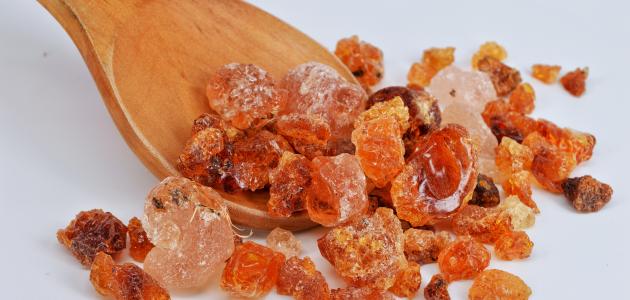Arabic gum
Gum arabic belongs to the legume family (Fabaceae), and is scientifically known as Sengalia Senegal. It has many common names, including Acacia senegal, Somali gum, Sudanese gum arabic, Egyptian acacia or thorny, and what is called Acacia vera, or Yellow thorn was used in ancient folk medicine, where the Egyptians used it as glue and to relieve pain. Arab doctors also treated a wide range of diseases through it. In the present time, gum arabic is used in pharmaceutical industries such as demulcent. In manufactured food products, and in emulsions, the bark fibers of its trees are also used to make ropes. Gum arabic is harvested from wild trees that grow in the Middle East, parts of Africa, and West Asia.
The benefits of gum arabic for the skin
There are benefits of gum arabic for the skin, including:
- Contributes to wound healing: When applied topically; Because it contains some chemicals such as alkaloids, glycosides, and flavonoids.
- Treats irritated skin around the colostomy: This is done by applying a thick layer of glue gel on the skin around it, which reduces skin inflammation better than applying zinc sulfate ointment.
- It is considered an anti-acne: This is done by using herbal exfoliating masks, which contain gum arabic.
- Treats freckles: It is also useful in treating dry and pale skin when using vegetable peeling masks, which contain gum arabic.
Health benefits of gum arabic
There are many benefits to gum arabic, and it is considered safe for consumption. It is included in various foods, cooking, and drinks, provided that the dose does not exceed 15-30 grams per day, but a doctor must be consulted before consuming it, especially if it is consumed as a food supplement or provided to children and the elderly, in order to ensure that there is no allergy to it, or its interference with some. Medicines, and its benefits include:
Read also:Skin care at night- It reduces pain, inflammation, and irritation, and is used for sore throat and stomach pain.
- Gum arabic contains fibers that control blood cholesterol, weight, and heart and blood vessel health, when consuming 15 grams of it in liquid form daily.
- It soothes the cough, coats the throat to protect it from congestion, and reduces its symptoms, such as loss of voice.
- It maintains weight and reduces body fat. One study also found that eating 30 grams of gum powder daily contributes to weight loss.
- It reduces dental plaque by chewing gum for 7 days.
- It reduces gingivitis, as applying a gel containing gum arabic and other ingredients after brushing the teeth for 6 weeks contributes to reducing severe inflammation.
- It treats dysentery, diarrhea, and intestinal diseases.
- It whitens the teeth, using the charred wood of the gum arabic tree, mixed with roasted alum and rock salt. The branches of this tree were used as a toothbrush in the past. To stop bleeding gums and strengthen loose teeth.
Benefits of gum arabic powder
Gum arabic powder is made by grinding the gum produced by the acacia tree. It can be consumed as a powder or capsules, and it has several benefits, including:
- Increases the amount of fiber; It is rich in soluble fiber, and its consumption is useful in relieving constipation, reducing cholesterol in the blood, and the risk of heart disease, and the powder can be taken as a nutritional supplement.
- It treats obesity by reducing body fat.
Foods containing gum arabic
Gum arabic is used in the food industry. It works as a stabilizer. Because it can bind foods together, and these foods include:
Read also:How can my face become clear?- sweets: It is added to hard sweets and chewy types of candy to prevent them from sticking to the teeth and to preserve the candy for a longer period.
- Soft drinks: And some other drinks; To increase its thickness, and increase its sensation when it comes into contact with the tongue.
- Spices to nuts: Where it is added; Because it is moist, which makes the spices stick well to the nuts before roasting them, and it helps in the process of coating the nuts with candy, such as pralines, which makes the candy stick well to the nuts.
- Low-fat salad dressing: It is used in its manufacture as a substitute for some fats, and to prevent the separation of oil from water. Gum arabic may be found in other products, such as dairy products, mustard, and canned baked goods, such as breakfast cereals, bread, and dried egg products. To enhance its soluble fiber content.
Side effects of gum arabic
Gum arabic is not considered a toxic substance, but it has side effects that may appear when ingested or inhaled its dust, including:
- It can increase cholesterol in the blood.
- It causes some skin lesions.
- It causes respiratory problems.
- Taking it intravenously causes liver and kidney failure.
- It may interact with some medications.
- The absorption of some vitamins is interfered with when an enzyme found in them is activated by heat.
Side effects of gum arabic powder
Gum arabic powder is consumed in an amount of one tablespoon with at least one cup of water, juice, or other liquids. However, it may cause some side effects, especially in the first week of consumption, and its effects include the following:
Read also:Skin care tips- Asthma attacks in case of dust allergy.
- Feeling bloated.
- Moderate nausea.
- diarrhea.
Gum arabic recipe for treating typhoid
Tea made from the bark of the gum arabic tree is considered a popular remedy for typhoid fever. Here is how to prepare it:
- Ingredients:
- Two tablespoons of gum arabic tree bark powder.
- Two cups of water.
- A teaspoon of ground black pepper.
- How to prepare:
- Add the bark powder to the water and boil.
- Leave to soak for 20 minutes.
- Add ground black pepper to the tea.
- Drink warm, daily for a few days.









